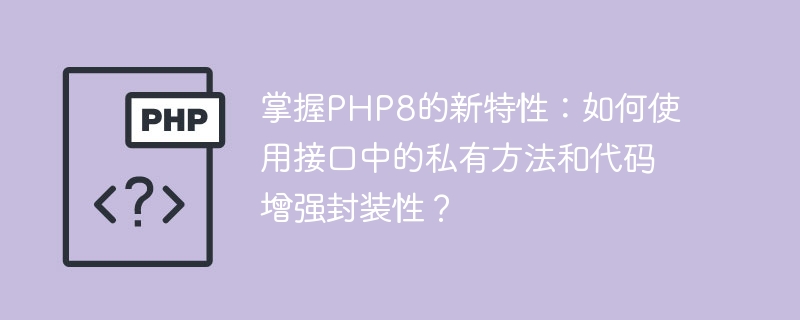

PHP8 is the latest version of the PHP programming language, bringing many new features and improvements. One of the exciting new features is the introduction of the concept of private methods and code in interfaces to enhance encapsulation. By using private methods in interfaces, we can better encapsulate and organize our code, improving the readability and maintainability of the code. In this article, we will detail how to take advantage of these new features to improve our PHP development skills.
In traditional PHP programming, we usually use classes and abstract classes to implement code encapsulation and organization. With the introduction of interfaces, we can better define our code specifications and make the code more reusable and extensible.
First, let us understand the concept of private methods in interfaces. Prior to PHP8, interfaces could only contain definitions of public methods. However, PHP8 introduced the concept of private methods. We can define private methods in the interface. These methods can only be used inside the interface and cannot be called in the class that implements the interface. This allows us to define some auxiliary methods in the interface to implement the internal logic of the public methods of the interface and improve the maintainability of the code.
The following is an example of an interface using private methods:
interface MyInterface {
public function foo();
private function helper();
}In this example, the interface MyInterface defines a public method foo() and a private method helper(). Classes that implement this interface must implement the public method foo(), but cannot call the private method helper().
Next, let’s look at how to enhance code encapsulation in the interface. In the past, we often defined some protected methods in abstract classes. These methods can only be called by methods in the inherited class and cannot be directly accessed by external classes. In PHP8, we can define protected methods in interfaces so that only methods in classes that implement the interface can call these protected methods.
The following is an example of an interface using protected methods:
interface MyInterface {
public function foo();
protected function bar();
}In this example, the interface MyInterface defines a public method foo()And a protected method bar(). Classes that implement this interface can call the protected method bar(), but external classes cannot access it directly.
By using private and protected methods in interfaces, we can better encapsulate and organize our code. Private methods in an interface can serve as internal helper methods for public methods in classes that implement the interface, making the code more readable and maintainable. Protected methods can limit the access scope of the method and improve the encapsulation of the code.
In addition to private methods and protected methods, PHP8 also introduces some other useful new features, such as named parameters, traditional constructor calls for anonymous classes, attribute derivation, and match expressions. These new features further enhance the functionality and flexibility of PHP8.
To summarize, the concept of private methods in interfaces and code-enhanced encapsulation introduced in PHP8 allows us to better organize and encapsulate our code. By using these new features, we can improve our PHP development skills and write more readable and maintainable code. In actual development, we should be good at taking advantage of these new features and use them flexibly to make our code more elegant and efficient.
The above is the detailed content of Master the new features of PHP8: How to use private methods and code in interfaces to enhance encapsulation?. For more information, please follow other related articles on the PHP Chinese website!